Parish Proclaimer


by Melinda Heatthcote Editor



by Melinda Heatthcote Editor
Welcome to our new Winter Edition of the Proclaimer.
As always, we have a variety of articles which we hope you will find interesting and informative, there is local news of our school, and the Cathedral choir, and some of the social events and celebrations which have taken place in the parish, along with photos.
Deacon Roger Stone, who is new to Arundel, has, as requested, written about himself and his work. He didn’t mention, however, that he is a recipient of the British Empire Medal for his work serving seafarers and rescuing trafficking victims over eight years. We are proud to have him as a deacon in our combined parishes.
There are more theological articles too from Jo Briscoe and Deacon David, and a lovely description of a visit to Ephesus and surrounding area by Peter Williams. Also the good effect that the parish and its people has had on a prisoner from Ford, now released and back at home, and some biographical notes by our retired nurses, giving an insight into their


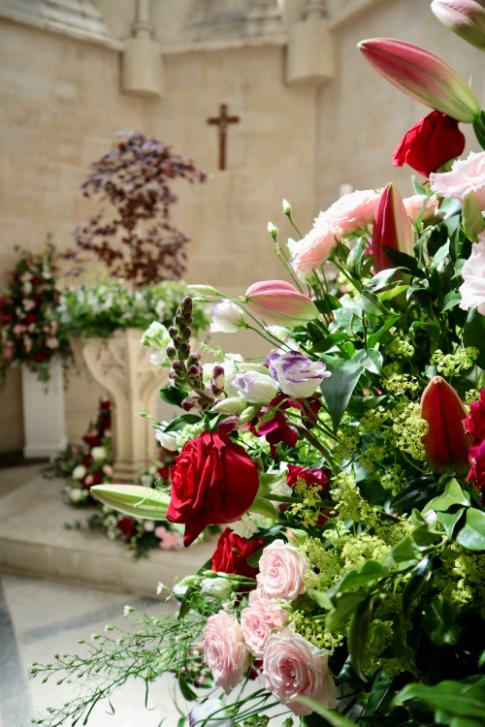
professional lives. A short piece on Assisted Dying by our organist, Pat D’Avray, and a lovely memory of the Clifton’s 50th Wedding Anniversary, plus a poem on Advent Carols, make up more of our variety of content. We also have a memoir of a beloved nun from the Poor Clares, Sr Giles.
The Friends of Arundel Cathedral are shown at their AGM, after a special Mass on the Feast of St Philip Howard, giving their generous donation towards the work of the Cathedral, and there is a description of Catenians’ day of Reflection, led by Canon Tim Madeley.
Of special interest is an article by Michael Cranfield on his involvement in Stella Maris (The Apostleship of the Sea) which is full of fascinating facts and detail. We also have some pictures of the Blessing of Graves which happened on 3rd November this year.
Bryden has done such a great job of putting all this together in such a professional and artistic style. I am sure you will enjoy reading and perusing the Proclaimer.
God bless and a very Happy Christmas to all,
Melinda
By Father Stephen Dingley
Welcome to the Winter 2024 edition of the Proclaimer. Many thanks to Melinda Heathcote and Bryden Isbister, and all who have contributed to its contents and production.
At this time of year our thoughts turn to welcoming Christ, the Word of God, once more into our world and our lives inAdvent and Christmastide. This year we will be welcoming the word of God in the Scriptures in a particular new way, as we will begin using the new translation of the Lectionary, i.e. the readings at Mass. For some fifty years we have used the Jerusalem Bible for the readings, but from the beginning of Advent throughout England and Wales we will start using the English Standard Version: Catholic Edition.
What will we notice? Mainly that the style is a little more formal and less colloquial,
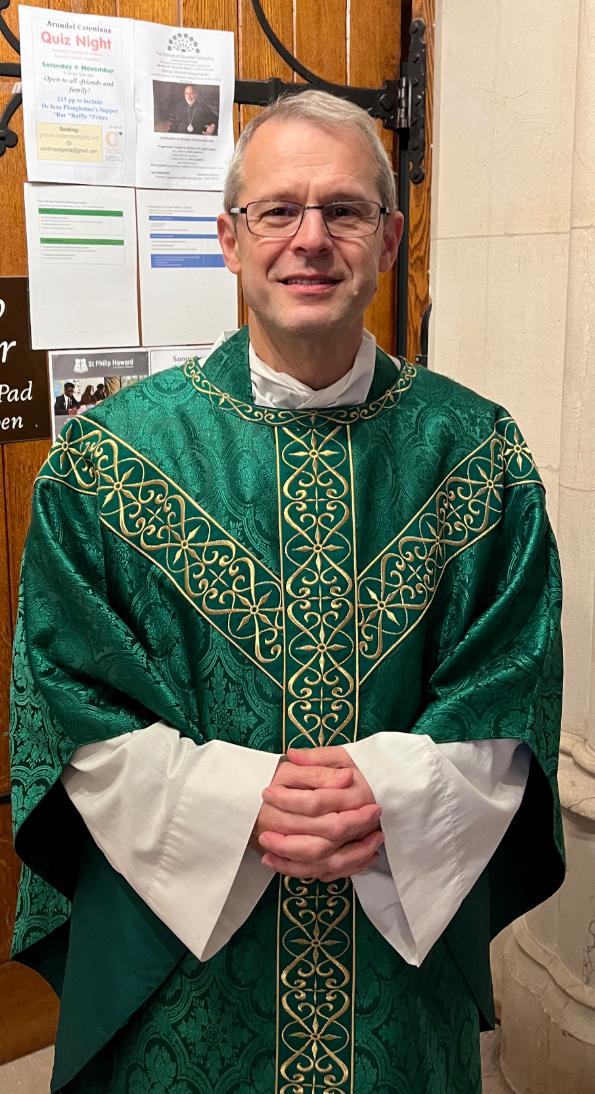
similar in style to the prayers of the Mass in their new translation (which, you may remember, was introduced in 2010). For example, in the beatitudes we will hear “Blessed are the poor in spirit,” rather than “Happy are the poor in spirit”; in the parable of the prodigal son, we will read that he “began to be in need” rather than that he “began to feel the pinch.”
At a deeper level, the new translation is more up-to-date than the previous one, incorporating the results of contemporary Biblical scholarship. It also aims more at word-for-word accuracy, rather than just trying to capture the gist and feeling of the original Greek and Hebrew. So we will be brought closer to the original text, written by the holy authors and inspired by the Holy Spirit, and we will come a little closer to the actual words spoken by Our Lord Himself 2000 years ago—which can’t be bad!
The new translation also gives us a wonderful opportunity to focus once again on the gift of Holy Scripture in our public worship, in our preaching and teaching, in our private prayers, and guiding our lives in following the Lord.
May God bless all of you and your families this Christmas.

By Michael Heathcote

Margaret handing the cheque to Bishop Riehard
On Sunday 20th October 2024 at 3pm Bishop
Richard Moth concelebrated Mass with Canon Tim Madeley and Fr Stephen Dingley at Arundel Cathedral, to mark the feast day of St Philip Howard.
This was followed by a reception in the Cathedral Centre, and then the Friends of Arundel Cathedral held their 25th Annual General Meeting at which time Margaret Bamford (Vice Chair) on behalf of Patrick Burgess (Chair) who was abroad, handed Bishop Richard a cheque for £57,000 as a donation towards the Cathedral’s considerable capital costs.
Both Patrick and Margaret are retiring this year, and very grateful thanks was given to them both for their many years of dedicated service on behalf of the Friends of Arundel Cathedral.
To become a Friend or to learn more please email: Lindsey Stratford at: aruncathfriends@btconnect. com

The Friends AGM in the Cathedral Centre
By Lucy Horne Headteacher

We are now well into the Autumn Term and our new Reception Class is well established. It has been lovely to welcome many families to our school community, getting to know all the individual personalities of our newest recruits. Our Year 6 Sports Leaders have stepped into their role of organising and playing games for the little ones at lunch time. They take the role very responsibly and seriously. It is a delight to watch the oldest and youngest children interact so well and form long lasting bonds of friendship.
We have again celebrated our Harvest Festival this year by giving thanks to God for all the foods we have but also by donating foods and household items to Littlehampton Foodbank. Families have been very generous in their giving and the Foodbank is, as always, very grateful for the support. For our children, it is great to see their ‘faith in action’ and recognise that small acts can make a big difference.
Our Year 5 and Year 6 children took part in a “Seed to Tree” project with Arundel Green Team this term. They walked through Arundel park and collected conkers, acorns and other seeds and planted them in empty water bottles. The seeds will germinate and the seedlings will then be replanted in order to help support the local environment.
We were delighted to be awarded the Green Flag Award for the work that our Eco Club and ambassadors have been doing for the last few years. This accolade recognises the work we do in school and in the local community. Well done to the leaders of this, whose tireless efforts make a huge difference to awareness and to the actions carried out around the school. It is now embedded in the minds of our next generation how important it is that we all take responsibility for our planet and become careful stewards of our local area.
Our Year 6 children recently went on their residential trip to PGL in Marchant’s Hill. The weather was kind and the children enjoyed having the freedom of staying away from home. They took on challenges to abseil, climb and swing. It is a great opportunity for these children to build independence and resilience whilst also having fun with their friends.
The school will once again be collecting shoe boxes filled with gifts to send to families in other parts of Europe. “Love in a Box” charity is one the families at

On the “Seed to Tree” project

St Philip’s always enjoy helping with. The children and parents recognise that they are helping children who may not have Christmas presents to open on Christmas day.
Sporting events have been taking place already this term with football fixtures, basketball, cross country and gymnastics. The children love
representing the school in the school sports kits whether it is for a friendly fixture, a competition or a festival.
We are excited to be opening our doors to the public for the “It’s A Wonderful Christmas!” Craft Fair on 30th November 2024 10am –4pm. We are very grateful to St Mary’s Gate Inn, Arundel, for their generous sponsorship of the event. If you are looking for your festive
fix, need to get presents or just fancy treating yourself, then come along and visit over 35 artists’ and makers’ stalls from across Sussex, Surrey and Hampshire. Festive fun for all the family, including face painting, children’s glass painting, tombola and of course Santa’s Grotto, which has been kindly sponsored by Angelica Care in Storrington. Visit our online platforms to find out more.


By Jo Briscoe

“The whole problem of our time is the problem of love. How are we going to recover the ability to love ourselves and to love one another? The reason why we hate one another and fear one another is that we secretly or openly hate and fear our own selves. And we hate ourselves because the depths of our being are a chaos of frustration and spiritual misery. Lonely and helpless, we cannot be at peace with others because we are not at peace with ourselves, and we cannot be at peace with ourselves because we are not at peace with God … Modern dictatorships display everywhere a deliberate and calculated hatred for human nature as such. The techniques of degradation used in concentration camps and in staged trials are too familiar in our time. They have one purpose: to defile the human person … Passive and despairing, we allow ourselves to sink back into the inert mass of human objects that only exist to be
manipulated by dictators, or by the great anonymous powers that rule the world of business … To find God one must first be free … To conquer the forces of death and despair, we must unite ourselves mystically to Christ who has overcome death and who brings us life and hope. This book is not a defence of a doctrine, but a meditation on a sacred mystery.”
Words from the Prologue of Thomas Merton’s book “The Living Bread”.
Thomas goes on to relate this situation of reality as follows:
“…to find Christ we must not only believe and be baptised in the Name of the Father, the Son and the Holy Ghost, thus becoming His members; we must go on to crown our sacramental life in Christ by partaking of the Living Bread of the Eucharist, the supersubstantial Bread which imparts, to those who receive it, everlasting life…… In Holy Communion, as we take Him to ourselves in the great sacrificial mystery which is the supreme expression of divine charity, we find that His charity gains possession of our souls and unites us to one another with a love so pure, so spiritual and so intense that it transcends all the powers of man’s natural love for his brother and for his friend. The charity of Christ in the Eucharist, seizing upon the best natural instincts of the


human soul, elevates and divinizes them, uniting men to one another in a charity and a peace which this world can never give.”
Thomas Merton was an American Catholic writer and mystic. A Trappist monk of the Abbey of Gethsemani, Kentucky, he was a poet, social activist and student of comparative religion. In 1949, he was ordained to the priesthood and given the name Father Louis.
Thomas was born in 1915 in Prades, France. His father, Owen Merton, was an immigrant from New Zealand and his mother, Ruth Jenkins, was an American Quaker – both parents were Artists. Thomas had an extremely disjointed young life when his Mother died - he was only six years old. Thomas travelled with his father with periodic visits to America to live with his grandparents. During his teenage years, his father enrolled Thomas in private schools in France and England, from which he
proceeded to Clare College, Cambridge. Following this, on the death of his father, he returned to the US to live with his grandparents, whilst at the same time he taught English at Columbia University.
My conversion to Catholicism was lengthy, widespread, and many faceted!
I was baptised and brought-up in the Christian faith within the Church of England. From a very young age our lives, apart from school, were connected to the Church – Brownies, Cubs, Guides, Scouts, as well as Youth Club, were all under the umbrella of the Church, and, equally, the activities of these organisations were centred on our faith within the Church.
As I grew up and, indeed, got older, there were many different influences which eventually reassured me of the path to be taken. Latterly, one of the many significant powers was given to

me by the writings of Thomas Merton.
After a rambunctious youth and adolescence, Thomas converted to Roman Catholicism whilst at Columbia University and in 1941 he entered the Abbey of Gethsemani, a community of monks belonging to the Order of Cistercians of the
Strict Observance (Trappists), the most ascetic Roman Catholic monastic order. His superior, Father Abbot, Dom Frederic Dunne, took note of Thomas’s intellect and talent for writing and encouraged him to follow his passion, saying it was within the will of God. Thomas started translating religious texts and writing biographies of saints for the monastery.
Merton wrote more than 70 books, mostly on spirituality, social justice and a quiet pacifism, as well as scores of essays and reviews. Among Merton’s books is “No Man is an Island”. ‘It is the book of a monk, who has learned much in the school of the love of God and is concerned to pass on to others the fruit of his contemplation. “He covers all the salient aspects of the spiritual life, and there is none that he does not illuminate” [The Tablet].
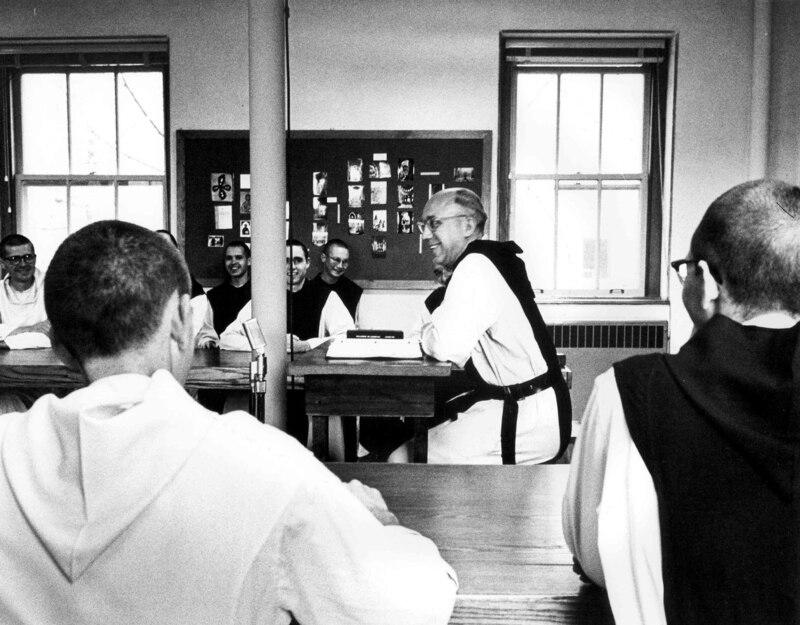
This is the book by Merton which sealed my conversion – his spirituality is so intense, but so freely and personally expressed that there is no question of its depth and guidance. “No Man is an Island” was the book recommended to me and it was my winner!
The title “No Man is an Island” was adopted by Thomas Merton from the writings of the poet John Donne who lived in the sixteenth – Elizabethan –century. John Donne’s mother was the great niece of St. Thomas More (who was martyred for his faith when Henry VIII broke his own faith’s connection with Rome). John Donne was born into a recusant Roman Catholic family but because of the Reformation and the illegality of Catholicism at that time, John was baptised into the Church of England and following ordination into the Priesthood, he became Dean of St. Paul’s in London, where he is buried.
John Donne wrote “The Church is Catholic, universal, so are all her actions, all that she does belongs to all… Who bends not his ear to any bell which upon any occasion rings? But who can remove it from that bell which is passing a piece of himself out of this world?” Thomas continues

“Every Christian is part of my own body, because we are members of Christ… But each one of us remains responsible for his own share in the life of the whole body. Charity cannot be what it is supposed to be as long as I do not see that my life represents my own allotment in the life of a whole supernatural organism to which I belong. Only when this truth is absolutely central do other doctrines fit into their proper context. Solitude, humility, self-denial, action and contemplation, the sacraments, the monastic life, the family, war and peace – none of these make sense
except in relation to the central reality which is God’s love living and acting in those whom He has incorporated in His Christ.”
Nothing at all makes sense, unless we admit, with John Donne, that:
“No man is an island, entire of itself; every man is a piece of the continent, a part of the main”.
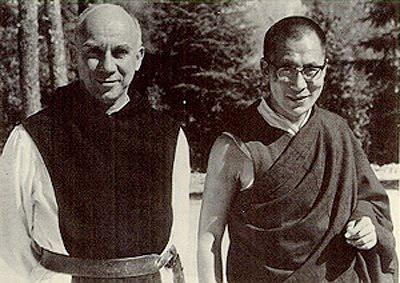
What has tethered me to Thomas Merton is his spirituality – he is spiritual within himself but he can inspire and urge his readers to experience their own depths of spirituality. He is able to express his own thoughts and feelings with an amazing reality which is truly difficult, and many people shy away from expressing their spirituality because of this difficulty. Read Merton and he will show you how it is done, whilst underlining your own thoughts and feelings. Done carefully, this is quite beautiful and certainly encouraging and enlightening. Thomas Merton’s writings appear to be talking to his reader personally, as if you are sitting opposite him, sharing a glass of wine, it is so intimate.
It is difficult to pick out sections to illustrate the true thinking of Thomas Merton – there is so much in his writing that, in my opinion, in order to really feel his true meaning, it is essential to read each book in its whole.
It is expressed that the most enduring work of Thomas Merton is his bestselling autobiography, “The Seven Storey Mountain”, which sent scores of World War II veterans, students, and even teenagers flocking to monasteries across the US. Share my experience and read it.
Thomas Merton was one of four Americans mentioned by Pope Francis in his speech to a joint meeting of the United States Congress on 24 September, 2015. Pope Francis said “Merton was above all a man of prayer, a thinker who challenged the certitudes of his time and opened new horizons for souls and for the Church. He was also a man of dialogue, a promoter of peace between peoples and religions”.

The Dalai Lama at Thomas Merton’s grave
By Alwyn Dow

I have spoken to a number of visitors from Ford Prison recently and here is a note from one of them to show his appreciation of the comfort and support that he has experienced with us at the Cathedral.
“Dear Friends,
My name is Hughie and I have been attending Mass at Arundel Cathedral for quite a few months now. I am not local but have been given licence from the prison authorities at Ford to enjoy a day out from time to time.
“I am also pleased to say that the Early Prisoner Release approved by the Government will also apply to me, and I hope to be home again with my family in outer London very soon.
“Before leaving I would like to say that my visits to the Cathedral have given me much heart and comfort over somewhat difficult times, so I would like to give a big THANK YOU to all those who helped me along the way. I plan to return for a visit with my wife in 2025, so until then please say a prayer for me. Love from Hughie.”
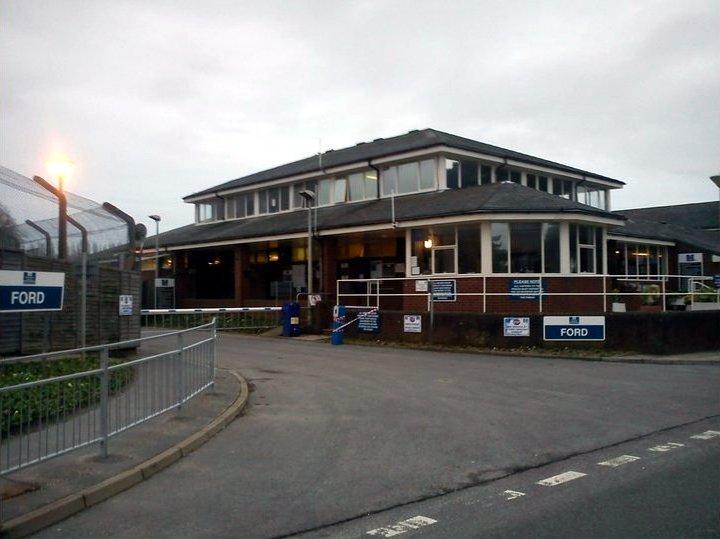
By Peter Williams
Sandra and I recently undertook a trip around Turkey, and studied some of the Christian sites there, which posed many interesting questions. We started in Byzantium (Istanbul), the ancient Greek city on the European side of the Bosphorus straights in Turkey, which was renamed Constantinople in 330AD, and became the capital of the Eastern Roman Empire. This extended south through the ten cities of the Decapolis in Asia Minor ending in modern Jordan as Amman (Philadelphia). After the conversion of Constantine the Great in 312, the Eastern Empire became Christian and remained so until the upsurge of Islam from 610, eventually resulting in nine Crusades to try unsuccessfully to protect Jerusalem in particular. This became Islamic in 1187 when captured by the Egyptian General Salah-al Din. Constantinople itself was finally overthrown by the Ottoman Empire in 1453.
So in 1453 the great Cathedral of Hagia Sophia (Holy Wisdom) on the Eastern edge of Europe at the Bosphorus, built by Justinian I over a millennium before, became a mosque, then in 1935 a museum. In 2020 President Erdogan decreed it would be a mosque again. There is an entry fee. We missed seeing the inside, as Christians are only allowed in parts of it. We moved on to Ephesus.
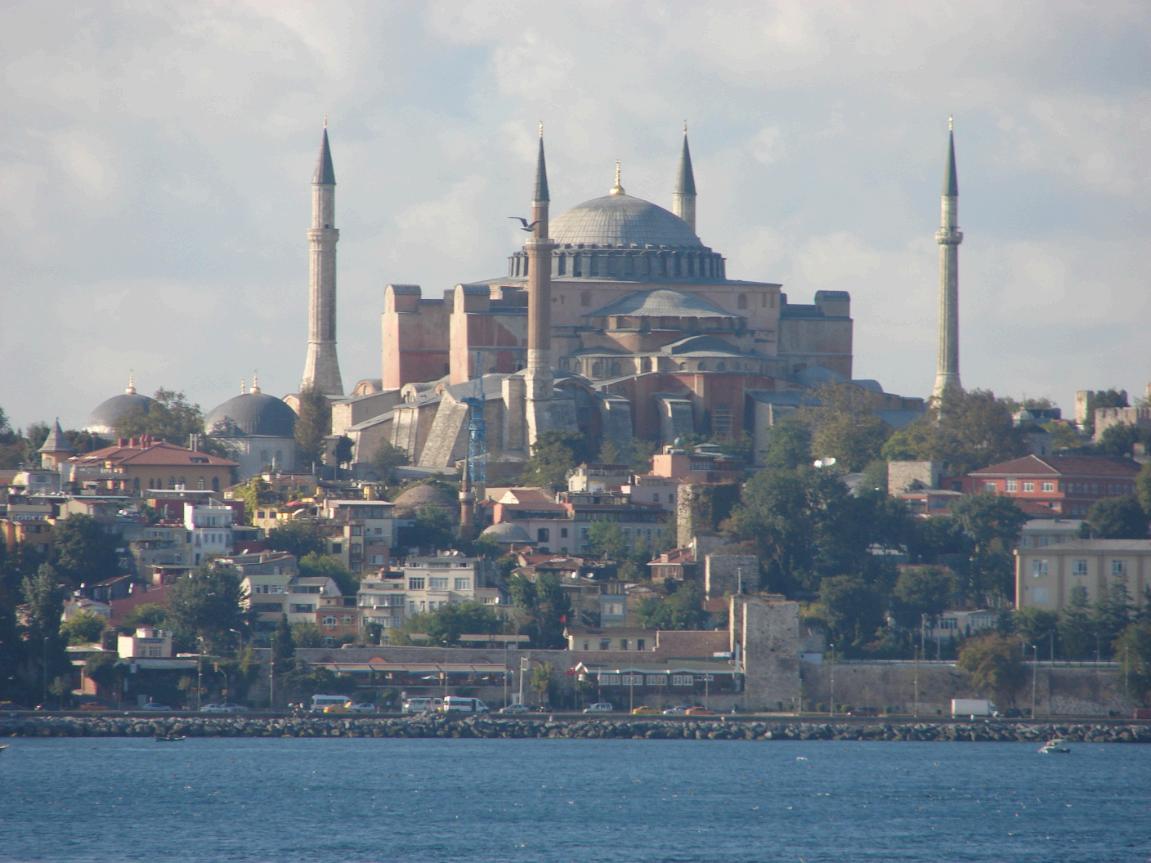
Hagia Sophia
Ephesus, on the Asian side of the Bosphorus inland from Marmaris, is much more interesting, as the place where St John is reported to have written the fourth Gospel, and where he is said to be buried nearby in Selcuk in a great ruined Basilica, in the process of renovation. This, like Hagia Sophia. was built by Justinian I. The city was founded about 700BCE and was an important centre of education, with a university including a medical school and a massive library. Heraclitus was a resident there and probably this is why St John is associated with the city, because Heraclitus wrote about the logos, the Greek for word, the active principle, the origin.
This origin is in metaphysical ideas and mind (idealism), not in nature or matter (materialism), which are to an extent illusory. The mind remains the same, time sweeps everything else away. “You cannot step into the same river twice” is perhaps the best-known quote from Heraclitus. Although things may look the same everything in the Universe has changed in a fraction of a second. The water may appear similar: the sky, the banks, the trees, but in this fraction of a second nothing

Model of the Basilica of St John in the ruins of the original
is as it was in macro terms, and these days in atomic terms. Countless trillions of atoms in your body are in different locations, as they are in the river and all of nature around you. The observer that is you is not material, and unlike the body is unaltered despite the passage of time. It is not difficult to see where the first Chapter of St John reflects the prevailing Greek metaphysics of the all-creative Logos; the word of God becomes incarnate in flesh and dwells
among us (John 1.14). This corresponds also to Plato’s theory of forms (C300BCE) where everything exists as a copy in time of a template in the mental realm. All that is truly real is ultimately the thought of God; I am that I am. The poisonous snake of ignorance, illusion, and self-sufficiency, the attraction and apparent reality of the empirical world, must be lifted from the ground, as with the staff of Moses, or Aesculapius in Greek.
Finally, meditation on Jesus himself is the cure “As Moses lifted up the snake in the

desert so must the Son of Man be lifted up”. (John 3.14.)
Near the top of a small mountain outside Ephesus is the remarkable house of our Lady, Mary, who was assigned to the mutual care of St John at the crucifixion. This house is in a very inaccessible and remote spot and revered by Christians and Muslims alike. Its whereabouts was revealed in a vision to Catherine Emmerich, an

Augustine visionary contemplative nun in Germany, which she never left. She was most insistent and convinced about it and eventually a French priest Julienne Gouet visited the spot and found the structure in 1881. It has since been visited by popes Paul VI, JohnPaul II, and Benedict XVI, and remains an enigma but both Muslims and Christians visit and venerate it in droves. A truly remarkable story. When found the roof was missing but it has been restored.
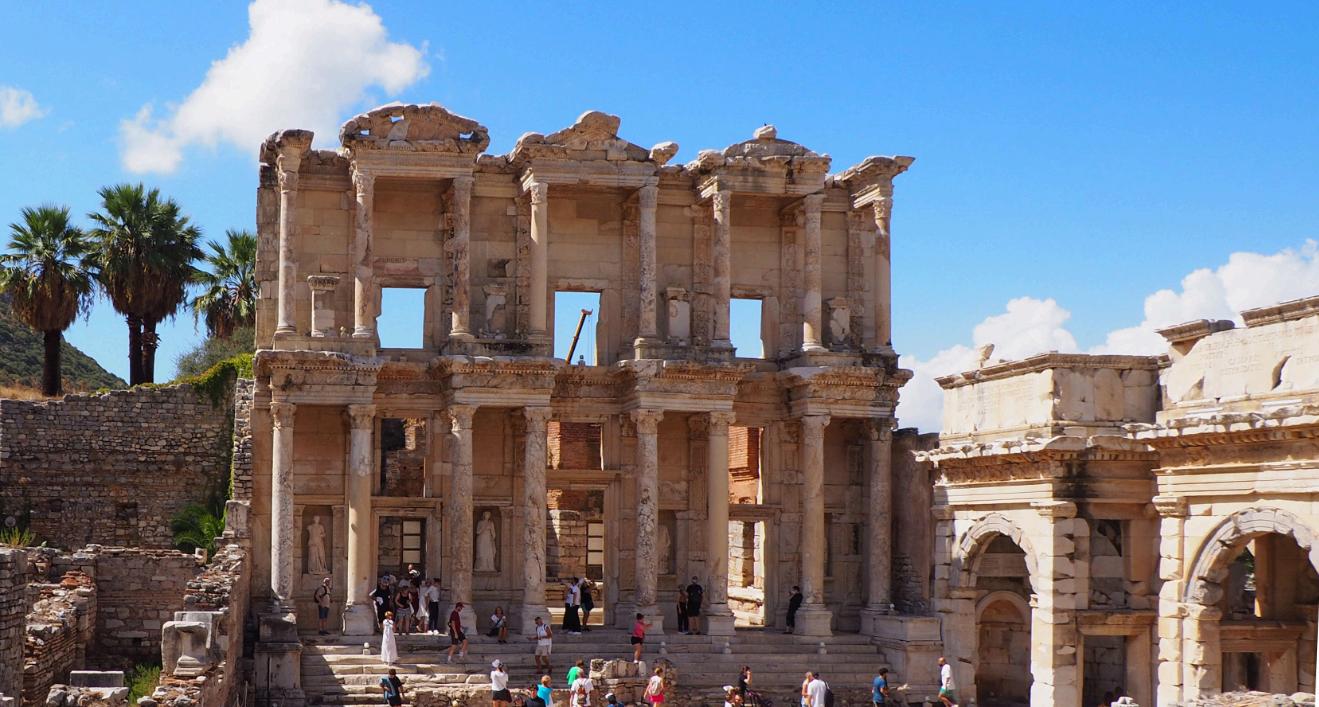
After Ephesus, we made an eight hour coach journey to Cappadocia with its famous hill caves often hiding Christian churches, and particularly the Monastery of St Basil. The landscape is remarkably arid and inhospitable, a reminder of the devotion put into the thought and prayer of these early Christians, undistracted from the multiple allures of the flesh in secular society.


The monastery is authentic, and there are some question marks over Ephesus but overall, the philosophy of the fourth Gospel does resonate with the Greek philosophical tradition, and the metaphysics is clear. “Heaven and earth may fade away; my words will never fade away.” (Matt 24:35). Jesus is referring not just to words in time, but eternal words, creative ideas, the archetypes of all there is or ever will be, because he speaks as the image in time of the Father, the ultimate being, the essence of love. There is no more to say, as his final words indicate “It is finished” (John 19.30).
By Sister Aelred

I lived at Crossbush with Sr Giles for only a few years but these are my recollections.
When I came to Arundel in 1977 from another community, there were then a community of 44 sisters, a lively and creative group, from the ‘20s to the ‘90s! It was a high point in the community’s history and life was full and varied.
In Sr Elizabeth and Sr Fidelis, we had two accomplished musicians; Sr Marion and Sr Beatrix looked after 12 beehives and we sold the honey; Sr Brigid cared for about 500 free range chickens; Sr Ann was such a remarkable gardener that we rarely needed to buy vegetables, we had masses of soft fruit and made our own bread. The Print Room was going at full tilt with Sr Frances Teresa, Sr Leo and Sr Giles working there full time, and providing the community’s only settled
income, producing high quality work on a wonderful old Heidelberg and a modern offset printer. Outside the Print Room was an exquisite little garden which Sr Giles had created from scratch, building a little flint wall. There was an archway with a zepheryne drouet climbing rose and several choice tea roses which still flower well and give joy years on.
Sr Giles taught herself glass engraving and the three windows at the west end of our chapel are her work. They commemorate the amalgamation in 1972 of Arundel Poor Clares with the Franciscan sisters of Goodings (founded in Penal times for exiled English women in the Low Countries) so they show Princenhof and Arundel on the outer windows of the three and in the middle the Tree of Life. In the Arundel window you can see our dog Laurie and also a beehive.
The windows were commissioned by Sr Pat’s parents, Averil and Jimmy Frame – great friends and benefactors of the community and they were a memorial to their son Kevin who had recently been killed in a car accident at the age of 21. So, for us they are a permanent testament to a great event in our community history, as well as a lasting reminder of the generous and gifted people who all through the years have been part of our lives and have greatly enriched us.

I think that Sr Giles was a born entertainer. She could mimic any speech and see the funny side of an event. She had spent some years at RADA and was a great gift to our community which in those days put on lots of plays and charades at Christmas and for big celebrations like Jubilees. Sr Giles was also one of several
outstanding readers and Sr Marion recalls how sometimes in the evening when there was a funny book being read, for example ‘My Family and Other Animals’ the community would laugh till they cried!! She was on the Community Council and had a book of poetry published – there seemed no end to her talents and she was much loved.
With all this in mind you can imagine the community’s sadness and incomprehension when Sr Giles felt that God was calling her to leave the community and go back to secular life. Thank God, when the dust settled, the bonds of love and respect were strong enough to sustain an infrequent but warm communication during the years that followed. As long as she was able, Sr Giles returned to visit now and then until she had to give up driving and being independent when she was received into Pendean, the Home where she ended her days. Thanks to the kindness of Joanna and Martin Hall, three of us who had known Sr Giles the longest were able to visit her in her last months and two of us were with her the day before she died. We are grateful to Joanna and Martin for their kindness to Sr Giles and to us for making this possible.

At Sr Giles’ funeral it was so good and healing for us to hear Fr Peter’s penetrating homily based on his years as her parish priest. Fr Peter spoke of how she continued to be a woman of God all those years, never missing an opportunity to do or speak a kindness, to let God communicate through her life. In short, she was a beautiful human being, whom many of us will remember with affection.
Rest in peace dear Sr Giles.
By Richard France
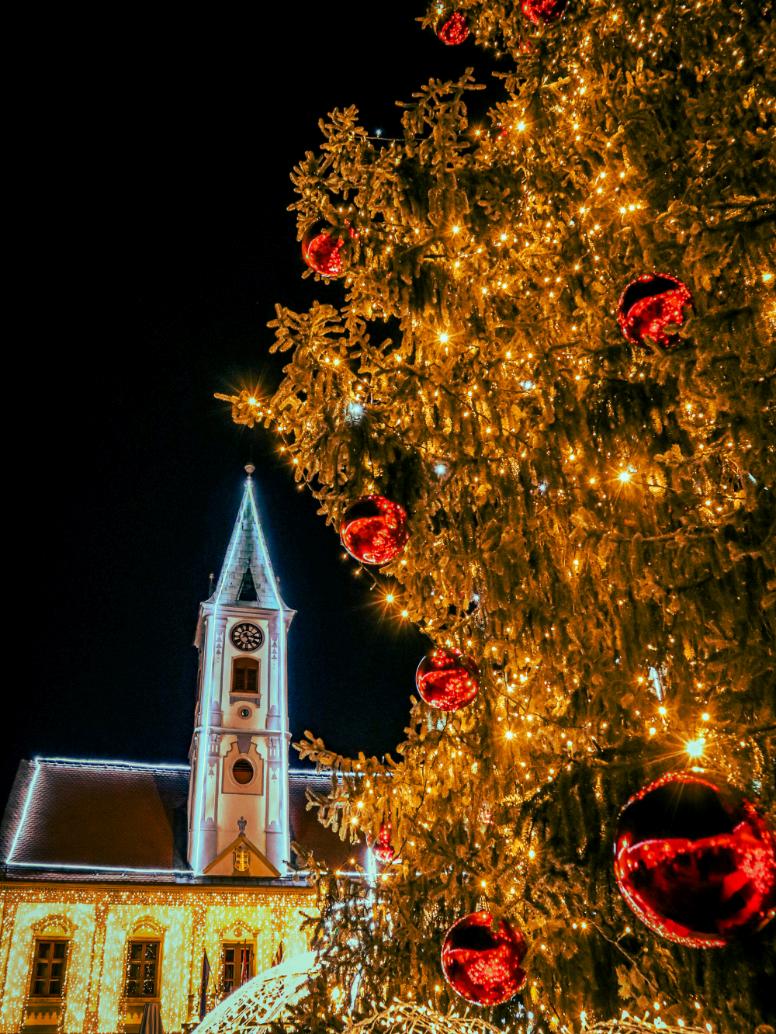
Sounds of joy that bring to mind
That wondrous night, long, long ago, When Jesus came to humankind, When heaven looked on earth below.
When angels glorified their king, Our Saviour, in a stable laid, Sang melodies that we might sing, To imitate the song they made.
Carried on the cold night air, Sung by the fireside at home, Or else inside a church somewhere, Perhaps beneath a splendid dome.
Such simple and yet special notes, Make up the carol’s joyful sound Which, like the lightest feather floats Upon the air, and echoes round.
Sung in the streets, played by a band, In theatres or in concert halls; And everywhere, throughout the land, The Christmas carol ever calls
The world to stop, and pause, and rest –
To think “Who gave us Christmas cheer?”
So every Christmas-time is blessed With carols, sung anew, each year.

By David Clifton

The book of Genesis tells us, "It is not good that the man should be alone" (1), as if human beings are incomplete without other humans to relate to. So God created for man a "helper as his partner" (2) a female, and instructed them to "be fruitful and multiply, and fill the earth" (3). From their very beginning, then, humans have been a social species, living in relationship with others. The nature of these relationships vary. Some are close and loving, others merely practical.
We are not individuals who happen to have relationships with others; these relationships constitute what we are. It can be said that we exist in "solidarity" with the rest of humanity. This is not to use the word, as is often done, as a political slogan or a philosophical or religious platitude. It is an expression of profound reality. It is not just empathy with others because we are "all in the same boat".
We are not in solidarity with other humans because we find ourselves in the same condition – rather, we are in the same condition because we are in solidarity with other humans.
Cardinal Ratzinger (later Pope Benedict XVI) develops this idea, describing sin as a "rejection of relationality". Human beings are relational and they find their identity in relationships. Sin is the damaging or destruction of those relationships. It alters the world and wounds it. So that from the beginning the network of human relationships has been damaged. Because sin is loss or disturbance of relationship, it is, therefore, not restricted to the individual.
When I destroy a relationship, then this event - sin - touches the other person involved in the relationship. Consequently sin is always an offence that touches others, that alters the world and damages it. To the extent that this is true, when the network of human relationships is damaged from the very beginning, then every human being enters into a world that is marked by relational damage (4).
The English divine, John Donne (1572–1631) wrote:
“No man is an island entire of itself; every man is a piece of the continent, a part of the main; if a clod be washed away by the sea, Europe is the less, as well as if a promontory were, as well as any manner of thy friends or of thine own were; any man's death diminishes me, because I am involved in mankind. And therefore never send to know for whom the bell tolls; it tolls for thee.” (5)


And Jesus told his disciples, "Just as you did it to one of the least of these who are my brothers, you did it to me" (6). This is not a pious metaphor, it is a statement of reality. This is why Jesus went further to insist, "love your enemies, do good to those who hate you" (7). This is not an appeal to go
beyond the call of duty. It is an imperative. It is necessary. It is a recognition that all humanity is fundamentally and intimately connected. If we love ourselves, we must love all humanity collectively and individually. So that if one individual acts without love (sin), the whole of humanity is affected by it.
We are part of the whole, so that what we are is to some degree determined by the whole.
And the whole has broken its relationship with God. Human nature is estranged from God, and by our very participation in that human nature we share in that separation. To put it another way: from the very first moment of our existence we enter the world without grace since we are cut off from the source of grace. That is why we need redemption. We cannot be our own rescuers. The grace we need can only come from God, and is offered to us as a free gift. The "solidarity" of the human race is also the reason for the incarnation. To redeem the human race, the redeemer must be fully, and in reality, a part of the human race (and his redeeming action is valid for the whole human race). He must also be God because redemption is beyond the capability of mere humans. It is in the incarnation that God demonstrates his total love for us, "No one has greater love than this, to lay down one’s life for one’s friends" (8). He looks to us to respond.

References:
1 Gen 2: 18
2 Gen 2: 18
3 Gen 1: 28
4 "In the Beginning … A Catholic Understanding of Creation and the Fall"
5 MEDITATION XVII, Devotions upon Emergent Occasions
6 Mt 25: 40 7 Lk 6: 27
8 John 15: 13
By Frances Challen

Fifty years after their marriage in Arundel Cathedral in 1974, Deacon David and Monica Clifton celebrated their Golden Wedding Anniversary in that same Cathedral on 10 August 2024, the Feast of St Lawrence, the patron saint of Deacons.
Their son, Fr Bruno Clifton OP celebrated Mass, attended by family, including their daughter Frances; friends and parishioners.
In thanksgiving of 50 years of marriage and their service to the Cathedral community, Deacon David and Monica were presented with a Papal Blessing on behalf of the parish by the chair of the parish Core Team, Betsy Vernon.

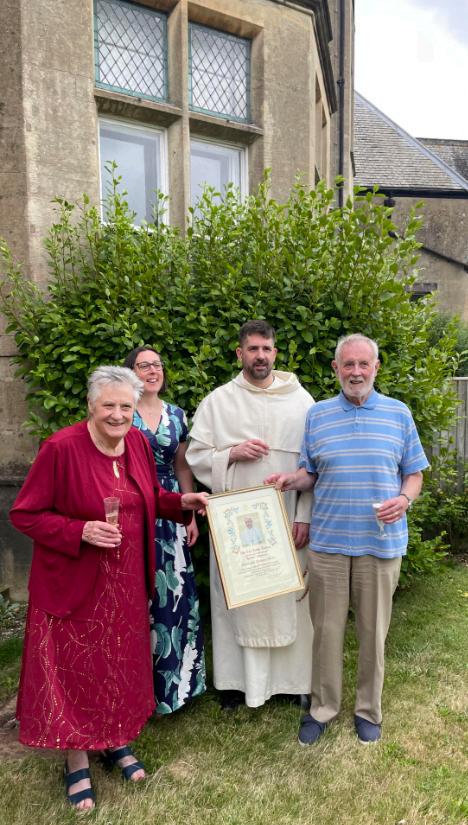

By Deacon Roger Stone

Deacon Roger
“What is a deacon?” In the Catholic church, Holy Orders comprise the Episcopate (a Bishop), the Presbyterate (a priest) and the Diaconate (a deacon). The word ‘deacon’ comes from the Greek word διάκονος which means ‘servant’. And a deacon is a man, ordained by a bishop, who is called to serve the People of God in the liturgy, word and charity.
Some deacons are transient because, in time, they will be ordained to the presbyterate, and serve as priests. Other deacons are permanent and they will not, or cannot, be ordained to the presbyterate.
The liturgical function of a deacon differs from that of a priest. A priest is ordained to reflect Christ as High Priest and a deacon reflects Christ the Servant. Sacramentally, only a priest can consecrate the Eucharist in the Mass, offer absolution in Reconciliation and anoint the sick. A deacon assists the priest
chiefly by proclaiming the gospel, preaching a homily, and, since a deacon is, like a bishop and a priest, an ordinary minister of Holy Communion, it is also his office to minister Holy Communion to the faithful who ask to receive the Lord’s Body and Blood. Deacons also baptise, witness marriages and preside at funerals and burial services. Deacons who are not to be ordained priest may be married and enjoy a full family life. They must be financially independent and are not remunerated by the Church. It is a wholly voluntary vocation, even though being ordained to Holy Orders means that it is permanent.
In the Diocese of Arundel and Brighton, deacons are assigned to deaneries. Earlier this year, Bishop Richard assigned me to serve as deacon in the Cathedral Deanery and specifically in the parish of Arundel with Storrington. I am thrilled to be able to do so. Susan, my wife, and I returned to Sussex after several years away and now live in Storrington where we intend to remain.
I was ordained in Our Lady of England Priory Church, Storrington in 2005 and served in the parish alongside the Norbertine canons until 2006 when the Bishop appointed me as Parish Deacon for Billingshurst with Pulborough. There was no resident priest at that time. And I was privileged to serve the parish for four happy years, supporting the growing worshipping community and performing the range of diaconal duties.

The ordination of Deacons Simon South and Dominic Dring by Bishop Richard Moth

In 2010 I applied for the post of port chaplain for the Apostleship of the Sea (now Stella Maris), based in Southampton and covering all ports from Weymouth in Dorset to Shoreham-by-Sea in Sussex. I served as port chaplain for nine very happy, demanding and rewarding years. At the start, I knew next to nothing about the
maritime industry but was soon supporting seafarers and fishers from around the world, principally from the Philippines, India, Romania, Ukraine and Russia. These days there are very few British seafarers. Every day I would climb gangways and meet seafarers, sometimes only for half an hour or so.
Sometimes I would meet them again but most of the time it was a one-off encounter. It was
genuinely humbling to witness how strong their Christian faith was. It was a real joy being able to share the gospel with them, and offer pastoral, spiritual and practical assistance to so many. Sadly, some seafarers were victims of physical, mental or sexual abuse, others had suffered abandonment, non-payment of wages or were enduring appalling conditions on board. The most extreme cases were those of seafarers and fishers who were victims of human trafficking and modern slavery. I was privileged to support quite a number of men from the Philippines, India, Sri Lanka and Ghana who had been cruelly abused by their employers and was able to rescue several men from vessels when they were in ports on the south coast of England. The Apostleship of the Sea, along with local Catholic churches in Southampton and other charities, helped them with accommodation, food and their daily practical and pastoral needs.

My role also involved working with a range of UK and international non-governmental agencies who assisted seafarers in trouble. Seafarers are notoriously suspicious and superstitious and a chaplain’s reputation depends to some extent upon word of mouth. On one occasion I received a plea for help from a seafarer on board a ship in
Thailand whose crew had not been paid for four months. I had never met him but he had heard that I had been able to help others and he contacted me on social media. I contacted someone in Hong Kong who contacted someone in Thailand and less than 24 hours later the ship was detained. The authorities did not release the vessel until all the crew had received all unpaid wages into their bank accounts. We must remember that seafarers are nearly always from poor countries, they work for several months without a day off and ‘sacrifice’ their lives for their families.
I also worked with colleagues in the Vatican arranging pastoral visits to crew on cruise ships by a


Fr Ricky Gente, head of the Filipino chaplaincy in Rome, celebrated Mass on board the Fred. Olsen ship Boudicca when the vessel docked in Civitavecchia
Bishop or Archbishop or the occasional Cardinal when the ship was alongside in Civitavecchia, near Rome. We also arranged a private tour of St. Peter’s basilica in Rome followed by a celebration of Mass at St. Joseph’s altar which was a real treat for everyone.
I am really happy to serve parishioners in Arundel and Storrington and am enjoying getting to know everyone and meeting occasional visitors to the churches. I very much appreciate the warm welcome which has been extended to me and hope that I shall be able to help in building up God’s kingdom in this beautiful part of West Sussex for many years to come.
Thank you very much and God bless all.
By Nigel Corby

As part of its spiritual dimension of prayer for themselves and others and concern for Christianity and the Gospel generally, Arundel and Adur Valley Circles of the world wide Catenian Association, celebrated the recent feast of St Philip Howard, co-Patron of Arundel Cathedral, by enjoying a Day of Reflection and renewal. The day was led by the Rev Canon Tim Madeley, BTh KCHS, former Cathedral Dean and now Priest for Billingshurst and West Grinsted.
The day started with Solemn High Mass and prayers for the Saint celebrated by Fr Stephen Dingley, new Cathedral Dean in the presence of some 30 participants and the general parish. Following this, in two fact packed sessions before and after lunch, Canon
Tim addressed the acute personal and spiritual issues that had faced St Philip Howard during the times of Queen Elizabeth I. There were great temptations to indulge in the “good life” of her Court, but at this postHenry Vlll turbulent religious time, things were never easy. In due time, Philip found himself greatly conflicted and challenged. In many ways this is a lesson for all in maintaining the faith and devotion against all odds. In due time he was incarcerated in the Tower of London where he was to spend the last 11 years of his short life, condemned by the State but not executed, as the Queen would not sign the death warrant.

Graham Monet with a member of the congregation

Canon Tim speaking to the group
Participants, who were led by Brothers Graham Monet and Alan Starley, respective Circle Presidents this year, were then greatly privileged, with the express permission of the Duke of Norfolk, to enter the private chapel in Arundel Castle grounds to celebrate a Benediction and prayerful half hour before the Blessed Sacrament which rounded up the day splendidly. All in all, this was an educational and informative experience and certainly gave each participant the opportunity to thank God for His great favours and to follow the examples of St Philip in our lives.

In the Castle Chapel


Entrance to the Castle Chapel from the Quadrangle
We have a number of retired nurses in the parish who have had very varied working lives. Here they have given us a few short biographical pieces – we are proud to have all these people in our parish. I think we probably all have occasions of gratitude to nurses in our own lives, the “angels” we don’t always acknowledge - MH.

In 1962 I travelled to the island of Malta, as a young nurse with Queen Alexandra’s Royal Naval Nursing Service (QARNNS).
My home was the Royal Naval Hospital Bighi, situated at the entrance to Grand Harbour, originally built as a private residence in 1852 and after a long and diverse history, converted into a hospital.
Our work was varied, caring for Naval and military personnel and their families, as well as troops from the many ships anchored in Grand Harbour. At times we were also seconded to the Military Hospital inland at Mtarfa.
Valletta, the capital, was accessible by ferry
and the colourful small boats known as Dghajsa, or less excitingly by car or bus. Malta and its extraordinary history gave us so much to explore, as well as time to enjoy the lovely beaches. The long, hot summers saw us in tropical white uniform changing into our Blues for the chilly winter days.
I returned to Royal Naval Hospital Plymouth for the icy winter of 1963 and some serious studying for the all-important final exams.
My nursing career took a long break with family life, but I returned to nursing in the 1980s, with several posts including at the MacMillan unit at King Edward VII Hospital, Midhurst and many years with Diocesan Lourdes Pilgrimage.
Many memories and friendships made.

I was three when the NHS came into being. Fifteen years later I began to train as a State Registered Nurse at Kings College Hospital. A three-year training with a fourth spent as a Staff Nurse. Trainee nurses were not allowed to be married, lived in Nurses Homes and had to be in by 10pm. My starting salary was £12 a month after deductions for board and lodging.
We wore striped dresses with detachable stiff white collars held in place by collar studs, which left rubbed marks on the neck. Starched caps and aprons and a navy blue cloak with a red lining.
The wards were Nightingale in style; twenty-four beds with gas fires in the aisle and a couple of side rooms. We student nurses spent a lot of time on
“tidy rounds” as the ward Sisters expected all bed wheels and pillow cases to face away from the doors. The patients were nursed in their beds or sitting out – no lounging around making the place untidy and no talking when a Consultant was conducting his ward rounds.
Kings was a happy place in which to spend those first four years, and I learnt so much there which stood me in good stead as the world of medicine and nursing continued to evolve as I moved on to pastures new.
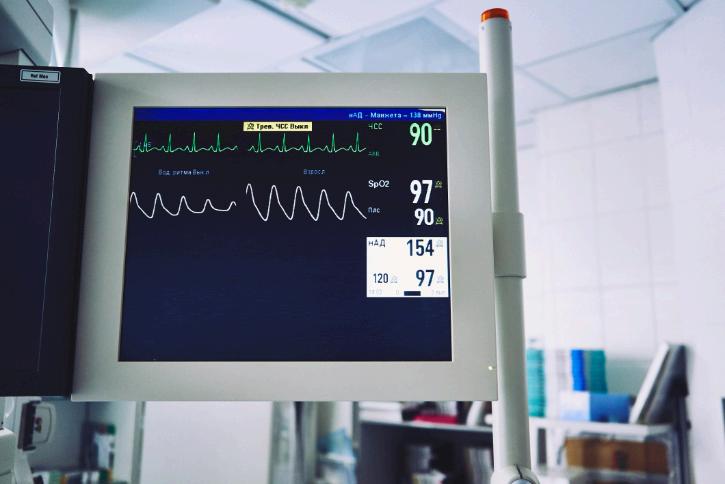
I trained as an RGN in my early forties. I worked initially as a hospital nurse on surgical and medical wards. Later I got a job at the Royal Marsden Hospital which I found very fulfilling. I later found my final place on the District as a Community Nurse.
At that time it was combined with social and nursing care. I liked visiting people mostly elderly in their homes. We were taught to be aware that we were visitors and respectful of their homes.
I had collected my list of people to visit and the first was an elderly gentleman who was bed-bound and lived with his wife. I went to wash and dress him and helped him to sit up. However, he suddenly had difficulty breathing and within a few minutes he died.

Instead of going to tell his wife I had finished, I had to tell her he had died. I stayed with her until the doctor arrived.
Marion Stratton
Before leaving school, I worked for a GP and family caring for their children. Then on advice from the parish priest I went to the Crusader of Rescue at Ladbroke Grove in London to care for abandoned children from babies to toddlers.
I later transferred to the Holy Child Nursery to care for babies and children up to five years old, trained for my NNEB attending Brixton College for two years. On completion I returned to my parents’ area in Christchurch to commence my SEN. Then moved to Chichester St Richard’s Hospital to gain experience and was recommended to go into a new shorter course

Marion Stratton
to train up to RGN which I did at the appropriately named Mayday Hospital in Croydon which had a very busy A&E department and medical and surgical wards. After qualifying I moved to a quieter location at the King Edward VII Hospital at Midhurst where I enjoyed working in the surgical ward for thoracic surgery and the first of hip and knee replacement surgeries.
My last placement was at Arundel Hospital as well as doing agency placements during
holidays. I also cared for private patients at home and one exceptional placement was at Osborne House on the Isle of Wight looking after convalescent patients.
I loved my work and met many interesting people. I also went on the Lourdes Pilgrimage as a nurse, which was great fun on the train journey caring for people in bunk beds on the hospital carriages and in Lourdes ward accommodation at in the hotels.


By Jo Briscoe

St Philip Neri is one of the best-loved saints of all time. Known as the ‘”Apostle of Rome’’ he set in motion a great renewal of Christianity at the heart of the Church’s capital city. St Philip’s foundation of the Oratory began by stimulating young laymen to conversion, prayer and apostolic works, and through them gradually brought about a reform of the entire Church, at all levels of society. St Philip inspired many through his words, his miracles and his spiritual gifts, which show many similarities with other great saints.
As is well known, originally our church was dedicated to the sixteenth century Italian priest, St Philip Neri (1515-1595). St Philip’s was seen to be a parish church for the Catholic community of Arundel and the surrounding villages in the Diocese of Southwark. With Duke Henry’s devotion to St Philip Neri, an altar was built in the south transept, as well as a statue of the Saint, with stained glass
windows above showing scenes from his life.
With the new Diocese of Arundel and Brighton created in 1965, the church became a Cathedral, with the dedication changing to “Our Lady and St Philip Neri”. Subsequently, in 1971 the remains of the martyred 13th Earl of Arundel, St Philip Howard (1557-1595), were brought from the Fitzalan Chapel in the grounds of Arundel Castle and enshrined in the Cathedral. The Cathedral’s dedication finally changed in 1973 to “Our Lady and St. Philip Howard”. This followed the canonisation of Philip Howard, together with 39 English and Welsh martyrs of the Reformation on 25 October 1970.
St Philip Neri lived in one of the most eventful centuries in the history of the Church: the time of the Protestant Revolt, the Council of Trent and the Catholic Counter-Reformation. Although the Church was then suffering from great laxity among both clergy and lay people, the 16th century was also the “Century of the Saints”. St Philip was a contemporary of numerous canonised saints, including St Teresa of Avila, St John of the Cross, and St Francis Xavier, and he knew personally
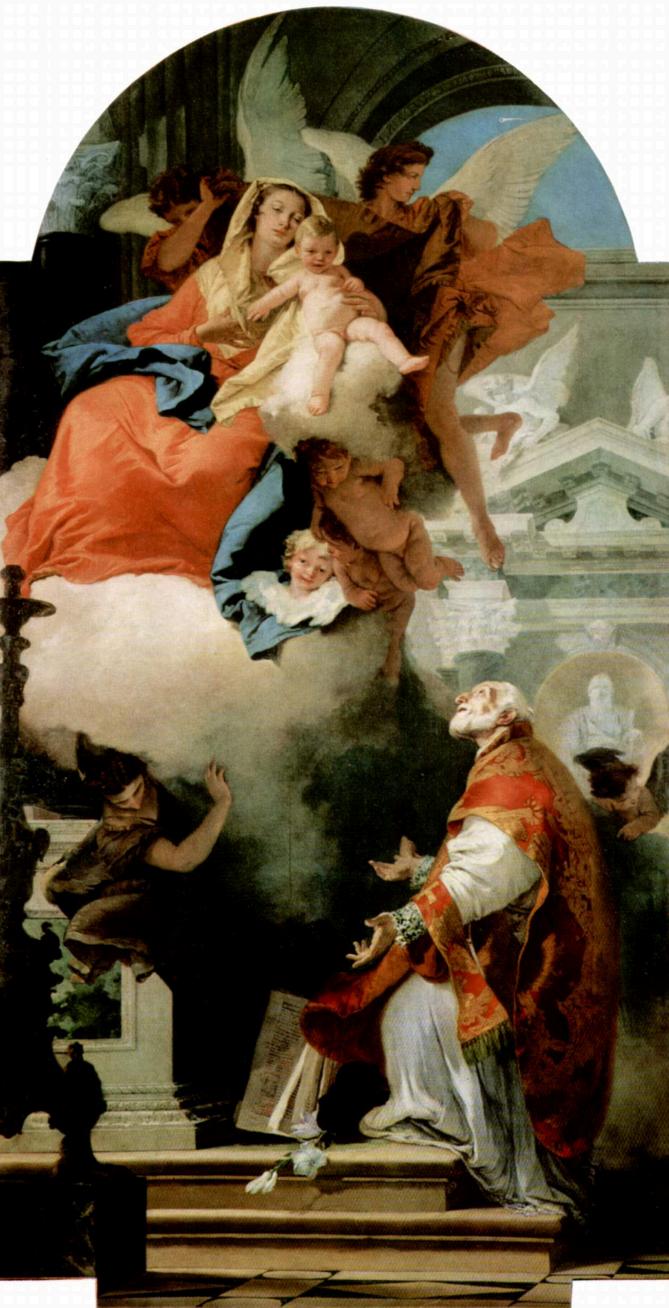
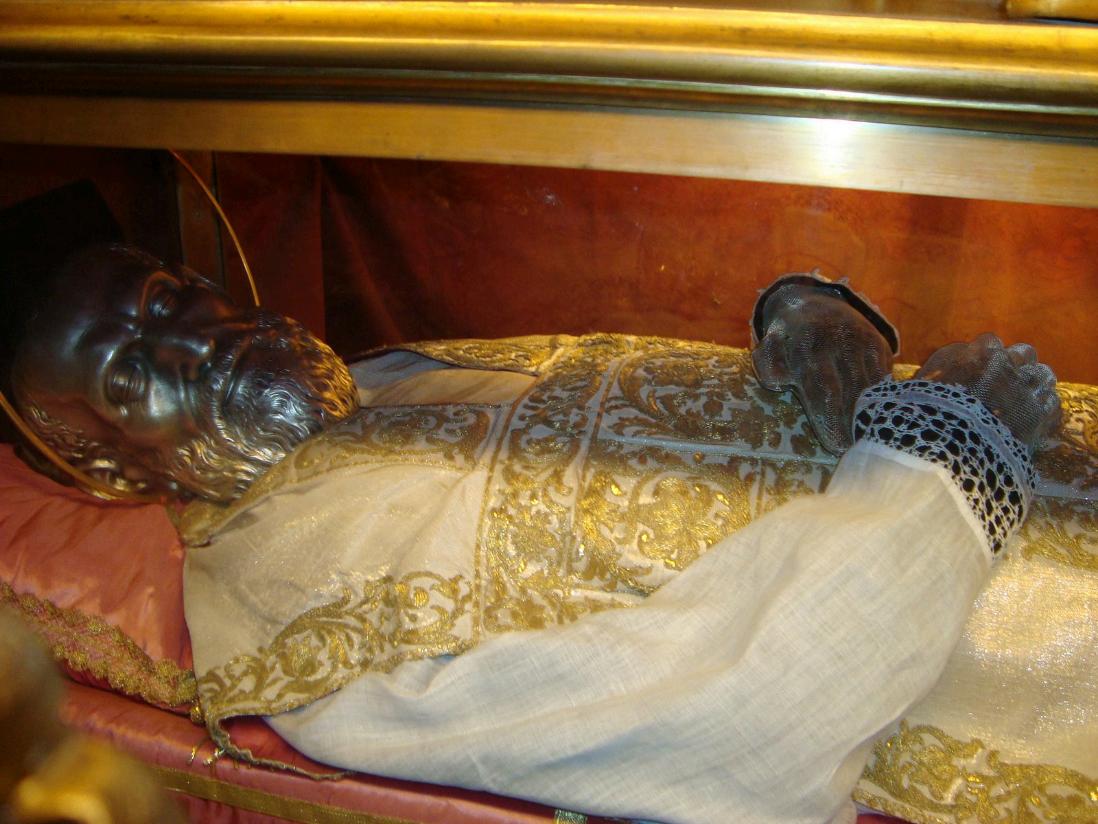
St Ignatius Loyola and St Charles Borromeo. Yet when we read the life of St Philip Neri, we find very little reference to the momentous events taking place in the Church as a whole. Philip was born in Florence, the eldest son of an established citizen of Florence and he lived with his family until reaching the age of 18 years.
Having spent his young life quietly visiting the churches of the city where he had a deep inner devotion to God, and, although he never spoke of being a priest or a monk, he loved to visit S Marco where he devoted his time praying, or sitting quietly in a corner of Santo Spirito delighted by frescoes in S Croce, or the paintings of Blessed Fra Angelico, often on his knees in cloister, chapter-room and
dormitory of S Marco. He also had special friends among the Dominican fathers (which lasted for the whole of his life). When he reached 18 years old he left Florence and went to live with an uncle in Naples. Close by there was a sanctuary dedicated to the Holy Trinity, belonging to the Benedictine monks of Monte Cassino, and to this chapel, reached by an iron ladder, Philip used to pray in quiet and solitude. Whether it was the result of some sudden and extraordinary mystical experience, or whether it came only through the gradually deepening understanding and conviction as to God’s will, by which the Holy Spirit ordinarily speaks to the soul disposed to receive his inspirations, here, at any rate, the decision was made. He would leave his uncle and any prospects of wealth that his uncle could hold out to him, and set out for Rome, to do whatever God should call him to do.
Beginning, probably, in 1534,

Philip followed the course of philosophy at the university of Sapienza, and subsequently the course of theology under the Augustinian fathers of St Augustine. His studies, however, were not allowed to interfere with his prayer; rather the contrary was the case. Because of his deep spirituality, Philip spent the next ten years
of his life as a hermit, made up of pilgrimages to Seven Churches as well as other places with holy associations, whilst living in the caves of S Sebastiano. In one particular chapel he had an extraordinary experience. He was twenty nine years old at the time, and as the feast of Pentecost was approaching, Philip, who had always had a special devotion to the Holy Spirit, was praying with extreme earnestness for his gifts and graces, when he seemed to see a globe of fire which entered his mouth and sank down into his heart. At the same time, he was pervaded by a fire of love which seemed to be a positive physical heat, so that he had to throw himself on the ground and bare his breast to cool it. When he rose he was seized with a violent

trembling, accompanied by an extraordinary sense of joy, and putting his hand to his heart, he felt there a swelling as big as a man’s fist. (After his death it was discovered that the first two of the false ribs were broken, and the broken ends thrust outwards, never having rejoined or returned to the normal position during the fifty remaining years of Philip’s life). At the same time there began that palpitation of the heart which lasted throughout his life, and made itself felt particularly when he was praying, hearing confessions, saying Mass or giving Communion, or when he was speaking on some subject which stirred his emotions.
At the beginning of the 16th century, the religious situation in Rome was corrupt and lukewarm, and the people lived in a state of spiritual malaise. St Philip’s mission was to convert and sanctify innumerable souls in Rome by preaching in the marketplaces, hearing confessions, directing souls, caring for the sick in the primitive hospitals of the day, ministering to needy pilgrims, and performing miracles, as well as by searching out wayward souls who did not recognise their own spiritual misery. This work was carried out through much personal contact and also through the congregation known as the “Oratory”.
Philip was ordained in 1551, at the age of 36 years. After his ordination Philip went to live at S Girolamo della Carita. This little church was the headquarters of an important Archconfraternity of Charity. The situation of the church gives us an interesting link between
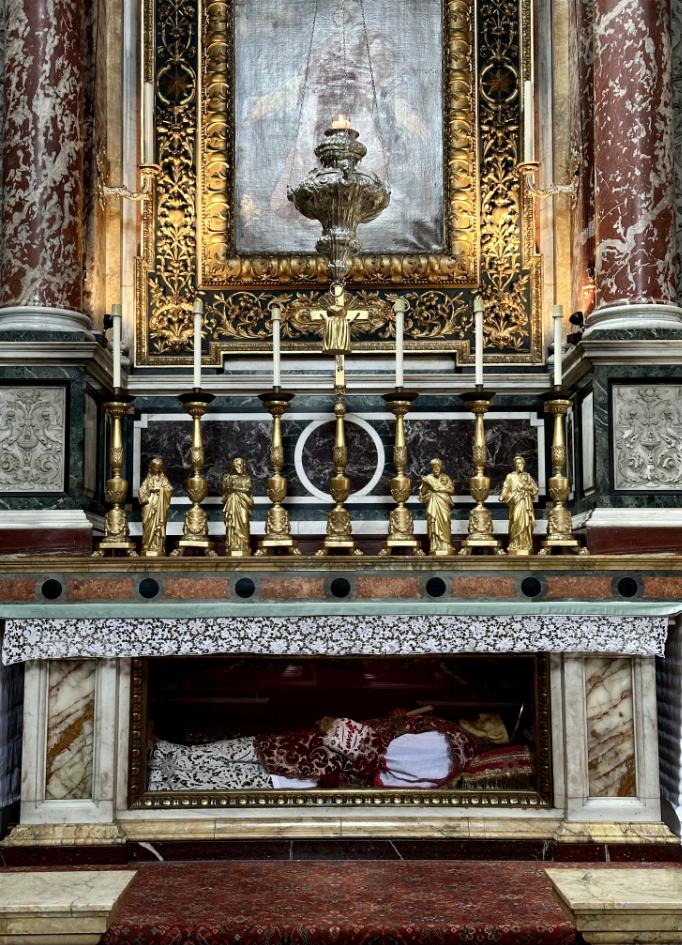
Philip and the persecuted English Catholics of Queen Elizabeth’s reign. The English College, founded by Gregory XIII, occupied, and still occupies, a site in the via di Monserrato directly opposite S Girolamo della Carita. Philip must, therefore, have been constantly meeting the young students of the college, and he used to greet them with the words of the hymn in the Office of the Holy Innocents: Salvete Flores Martyrum (“Hail, flowers of the Martyrs”). There is a tradition that they always went to get Philip’s blessing before setting out for their own country as priests, with the
certainty of having to face a dreadful martyrdom should they fall into the hands of Elizabeth’s Government; but anyone who neglected, out of contempt, to get this blessing, ended by falling away from the faith.
In those early days Philip would go down to the church first thing in the morning to his confessional, and scarcely stir from it till noon, his usual time for saying Mass. If no one came, he would stay near his confessional reading or saying his office or rosary; or he would walk a little way outside the church, so that casual passers-by could see that he was available. Soon, however, there was never any lack of penitents. Those who went to Philip once,

especially if they were young men, were conscious of some peculiar attraction in him which brought them back to him again and again, so that before long it was no extraordinary thing for him to have heard as many as forty confessions in his room before going down to the church! After the conversations they used to go for a walk together, perhaps to visit some church or other, and some of them would go back again with Philip to S Girolamo for prayer in the evening. These two features, the conversation in the afternoon and the prayer in the evening are of great importance; they are the germ of all that the Oratory was to become in its most essential elements. Philip led these young men towards devoting their lives to God.
Philip’s apostolate and the spirit which directed it seemed to be that his method was to have no standardised form; he acted from day to day and from hour to hour according to the impulses of tender charity which moved him to treat one soul in this way and another in that, in obedience to
the interior movements of the Holy Spirit, whose guidance he so humbly and constantly sought and so faithfully tried to follow. He won souls partly by his personal charm, and partly by the exercise of supernatural gifts. His friends testified of him that “He was so affectionate that he drew all the world after him in the most wonderful way imaginable.”
It was his desire to kindle in others the fire of the love of God with which he himself burned, a fire kept alive within himself by his unceasing prayer.
Unlike many of the great saints of that era, St Philip found that his vocation was to a single city. The exact nature of his vocation had not always been clear. When he was around 42 years old, after having been a priest for about six years, he and several companions began reading the letters of St Francis Xavier and other missionaries in India.

They became fired with enthusiasm to go to the Far East to save souls and win the crown of martyrdom. But to make sure of God’s will, Philip consulted a holy Cistercian who was favoured with visions of St John the Evangelist. The Cistercian reported that St John had appeared and had delivered this message for Philip: “Rome is to be your Indies”.
To the souls in Rome, then, St. Philip devoted his life. The distinctive mark of his apostolate was cheerfulness, and everyone was captivated by his supernatural charm. Philip soon became the most popular person in the city and was generally known and loved as “the Apostle of Rome”. He was loved for his own sake and for his influence on Oratoriansincluding St John Henry Newman – right down to our own times! The improvement in the religious spirit of Rome between the opening and closing years of the 16th century is largely attributable to this one man. By all he did to sanctify Rome, St Philip Neri exerted an incalculable influence for good upon the Universal Church, which owes him – even to our own time – a debt of unimaginable magnitude.
By Michael Cranfield

Mary, Star of the Sea, stained glass window - Goleen, Ireland
The official maritime Charity of the Catholic Church, previously known as The Apostleship of the Sea, is now Stella Maris. The headquarters of the charity is based in Rome, Italy.
It is also the largest ship-visiting network in the world, covering 339 ports and served by 227 Port Chaplains.
Stella Maris is the Good Samaritan for seafarers and fishers, in good times and in bad, but is only able to undertake such work by virtue of the generous donations of supporters and volunteer ship visitors generously giving up the necessary spare time.
For example a few years ago Olek, a Ukrainian seafarer, was working on the deck of a cargo ship when he had a serious accident. He fell into the hold and broke his back. He was taken
to Hull Royal Infirmary for urgent medical help. He spoke very little English and had no family or friends here to support him.
Fortunately Anne McLaren, a Stella Maris Chaplain, went and visited him in the hospital. During that first visit she found out that he was from Ukraine, his house had been bombed and his family were still sheltering in the city.
Can you imagine how it must feel to be seriously injured, so far from home? Worried about your health, not able to speak the language of your doctors, and knowing your family are trapped in the middle of a war thousands of miles away, and you are unable to help them.
Olek stayed in Hull for several months while they stabilised his spine. Throughout that time Anne and volunteer Ship Visitors from Stella Maris visited him regularly and supported him. They arranged for a translator, brought him clean clothes, toiletries, and mobile phone SIM cards so that he could contact his family back home. They made sure that he was not alone and not forgotten. He had a friend.

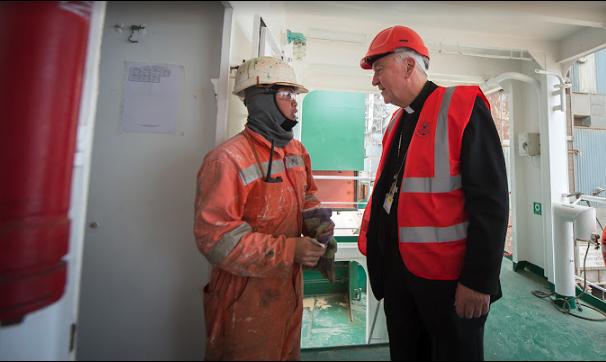
Concern for the welfare of the stranger, and the value of friendship to those who are far from home, is exactly the reason why Apostleship of the Sea was established over 100 years ago. And today this has never been more relevant for Stella Maris.
In the last few years more crews have been abandoned by their employers than ever before. Many seafarers are still being denied the right to leave their ships for even a short break away from the relentless noise and pressure on board. Many are reporting more stress and worse mental health, and the war in Ukraine has added to crew shortages and
When I became a registered Ship Visitor for the port of Shorehamby-Sea, with Deacon Alan Veness our mentor accompanied us on our first visits aboard vessels at berth, there was Deacon Roger Stone. Deacon Roger was the Port Chaplain at that time.
So please remember seafarers in your prayers. Thank God for them and the vital role they play in our lives, often working in difficult, hazardous conditions. Please pray for the Stella Maris Chaplains and the volunteers.
A Vatican postage stamp celebrating the 100th anniversary of the Apostleship of the Sea shipping turmoil.
The work of the charity is usually celebrated at Arundel Cathedral and local Catholic churches annually on Sea Sunday, with an appeal for donations after the Masses.
To conclude with words from Pope Francis: “The life of sailors, fishermen and their families is very difficult. Sometimes they are

victims of forced labour or are left behind in distant ports. But without these people of the sea, many parts of the world would starve”.
By Margaret Bamford

Preparing for the visit
The Friends of Arundel Cathedral like nothing more than an opportunity, to welcome visitors. They particularly enjoy being able to introduce newcomers to their Cathedral. The more the beauty of the building can be promoted, and the more awareness of the richness of its history can be emphasised, the better. Pilgrims visiting regularly from all over the world is testimony to its unique spiritual importance in Christian Catholic worship in this country. But it is not only from an international fraternity that there is such interest.
As readers of the Proclaimer will know, Arundel Friends have previously welcomed groups from closer to home. In the last couple of years Friends from Chichester and Canterbury cathedrals have made day trip visits, and enjoyed a programme of talks, guided tours and the hospitality of delicious home-made soup, sandwiches and cakes.
This time it was Friends from St Albans, and as the previous events had been so well evaluated, the same format was followed. Welcomed personally by Bishop Richard, who regards such trips as a priority for his diary, the group was escorted to the Cathedral where Oliver Hawkins, our resident expert who protests at being described as such, but for whom so many have such respect, described how Henry, 15th Duke of Norfolk, commissioned architect, Joseph Hansom, to design and oversee the building of the Cathedral, including the very considerable challenge of building such a substantial structure on solid chalk. Anyone who saw the exhibition of the Cathedral’s 150th anniversary in the museum last year will have seen and heard Oliver’s erudite recorded film presentation. It was masterly and the group from St Albans thought so too. Having braved the long and challenging journey round the M25 in the rush hour, at the end of the day there could be no warmer compliment than that the journey had been worth it!

Lindsey Stratford, Liz McCombe and Maggie Burgess

Following the guided tour of the Cathedral, Oliver took the group across the road, to the quiet peace of the Fitzalan Chapel, the final resting place of former Dukes. It is a much older building than the Cathedral, dating
back to 1380 with Gothic architecture, carved timber roof and choir stalls. Exquisite! Such an appropriate way to complete an introduction to the richness of what Arundel Cathedral, the seat of the Bishop of the Diocese, has to offer visitors and pilgrims.
The thousands of motorists driving along the A27 every day marvel at the magnificence of the Cathedral’s location, high above the coast and South Downs but its maintenance is expensive.The Friends of the Cathedral provide essential income for maintenance of the fabric of the building, and additional funding for the replacement of essential ecclesiastical items. Interest in becoming a member of the Friends is welcomed. Activities include Advent vespers, a summer event in the Collector Earl’s Garden, pilgrimages, lunchtime talks, an outreach Education project, and supporting the Director of Music’s events reaching out to families in the community. Being a member can be great fun and new members are welcome. Members can be as involved or as inactive as they wish. More information from aruncathfriends@btconnect.com; or Lindsey Stratford 01903 884567
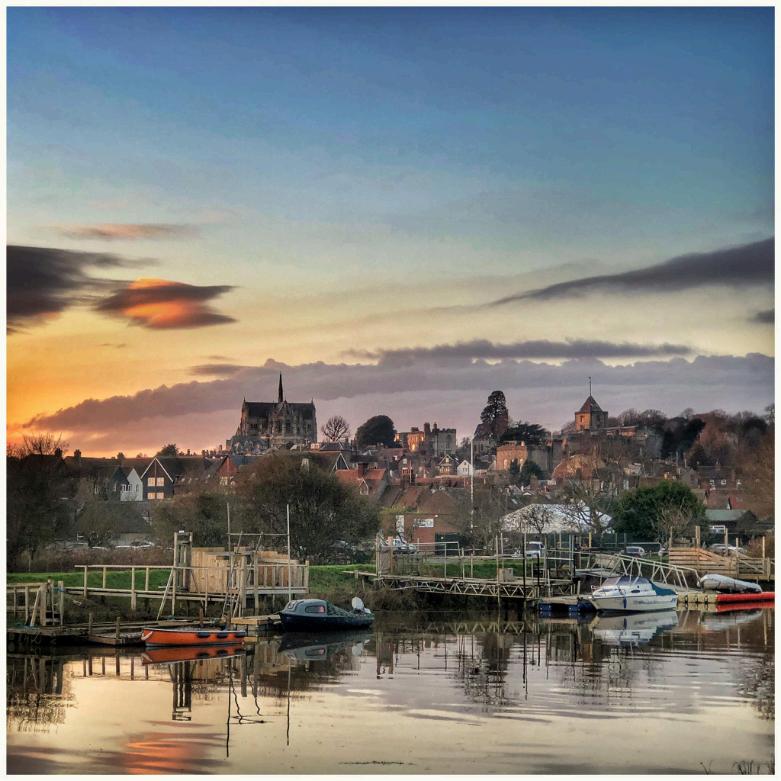

By Pat D'Avray

Father Stephen spoke powerfully recently at Mass on the subject of ‘Assisted Dying’. A vote in Parliament is due to take place on the 29th November (2024) on the Private Member’s Bill put forth by Kim Leadbeater, which proposes that Assisted Dying should be legalised in this country. Therefore, if a patient requested that their life should be terminated, then a doctor would be legally required to end their life or give them the means to do so.
Assisted Dying is a very topical issue which has received a lot of publicity recently, with statements from prominent public figures such as Esther Rantzen. At first sight it may seem to be the right and humane thing to do, to allow a person to take their own life, or allow a doctor to do so, if they feel their pain and suffering to be intolerable. Indeed it is heartbreaking to see great suffering, and everything possible should be done to help to
ease the suffering of those in sickness and pain.
The way forward is for effective palliative care to be given with compassion and understanding, and true appreciation of the sanctity of each person’s life. All medical endeavour should aim to relieve pain, suffering and distress, without recourse to ending the person’s life, and very good palliative care is indeed available. There are in fact already legal safeguards in place - doctors are allowed to administer drugs to relieve intense pain, even if there is a risk to the patient’s life.
The current proposals given in the Assisted Dying Bill require strict safeguards and authorisation from doctors, before a person is given the means to end their life, or to have a lethal injection given to them. However, in countries where Assisted Dying has already been legal for some time (e g Canada), these safeguards have been steadily eroded, and the number of people undergoing Assisted Dying has inexorably risen.
Pressure on a sick person to end their own life can very often occur, for a variety of reasons.
It is striking that it has been clearly shown, in recent surveys, that those doctors who


personally care for the seriously and terminally ill are those most strongly opposed to Assisted Dying.
At the heart of this is our belief in the sanctity of human life, a fundamental Christian truth: “Your bodies are temples of the Holy Spirit, who is in you, whom you have received from God”. (St. Paul’s letter to the Corinthians).
I quote in conclusion from an excellent recent newspaper article, opposing Assisted Dying: “With the reality of disease and death hidden behind closed doors, we are liable to catastrophise old age and illness - and demand the freedom, by passing and expanding assisted dying legislation, to hit Escape and leave the game early”.
The consequences of this Bill becoming law would be immeasurable and tragic.
By Elizabeth Stratford


On a chilly Sunday in January the Cathedral Choir boarded a coach bound for Oxford. The reason? An opportunity to join forces with the Choir of Exeter College Oxford to sing an Epiphany Carol Service. This was particularly exciting as most of the choristers had never visited Oxford before and we don’t currently have an Epiphany Carol Service so it was a great opportunity to learn some new music. As the coach pulled into Oxford there were lots of oohs and aahs at “the dreaming spire” and various chapels. After lugging suitcases full of cassocks into Exeter College we were shown into the Rector’s Drawing Room where lunch was eagerly consumed by all.
The adults and Choral Scholars were given some free time before rehearsals began and the choristers had a whistle stop tour of some of Oxford, taking in various landmarks such as the Radcliffe Camera and the Bridge of Sighs (Hertford Bridge) and pausing for a few
photographs. They were also able to see the Fellows’ Garden in Exeter College and look out over Oxford taking in wonderful views, but were most excited about shopping with a number of them buying Oxford University hoodies and T-shirts which they were very pleased with.
Once back at Exeter College, the choir were able to fully appreciate Gilbert Scott’s beautiful chapel, strongly influenced by French architecture and the Parisian medieval La Sainte-Chappelle in particular. Looking up in wonder, we were able to see beautiful stained glass windows by Clayton and Bell and the famous tapestry, The Adoration of the Magi, by Edward Burne-Jones and William Morris. We met the College Chapel Choir, primarily made up of undergraduates, and the College’s two organists, Michael Koenig (graduate organist) and SJ Park (organ scholar) then began rehearsal. John Sharples shared the playing with Michael whilst Elizabeth and SJ shared directing the choir. Music spanned centuries and included Samuel Scheidt’s setting of “Puer natus in Bethlehem, Lo! star-led chiefs” (William Crotch) and “Seek him that maketh the seven stars” by Jonathan Dove.
After rehearsal it was back to the Rector’s Drawing Room for refreshments and a little stretching of legs before the service began.


In front of the Radcliffe Camera
It was wonderful to see a full Chapel for the service and we began with the introit by Scheidt before processing into Chapel and taking our places in the choir stalls during the first hymn. After the reading, the choirs sang “Lo! star-led chiefs” and the service continued with prayers and readings. Mendelssohn’s setting of “When Jesus
our Lord/Say where is he/There shall a star from Jacob come forth” were expertly accompanied by John Sharples on the Chapel organ, built by Walker and described as “an English organ with a French accent”. Other music included the traditional “Coventry Carol”, “To the Jordan Jesus came” (Paul Nicholson) and Jonathan Dove’s “Seek him that maketh the seven stars”.
After the service refreshments were served before we all boarded the coach back to Arundel, tired but happy. We are very grateful to all who made our trip possible and our particular thanks go to Michael Koenig, SJ Park, Canon David Parmiter and Rev’d Andrew Allen. We look forward to welcoming the Exeter Choir to Arundel in the future!



By Betsy Vernon

Yearly Daffodil bouquets were prepared and presented to all ladies who attended Mass at the cathedral. Prepared by Betsy and Adam on Mothering Sunday and also any who came to partake in the breakfast in the Cathedral Centre that was laid ready for all to be seated.
A variety of different croissants were served, along with orange and apple juice, and some chocolate treats hidden beside each place setting. Each year the numbers seem to get greater.
Thank you to the gentlemen who kindly served the refreshments on that day and generally tidied away instead of the ladies.
This activity links directly with the mother church for our cathedral moderated parish that of the Diocese for Arundel and Brighton and all the other moderated parishes that make up our catholic diocese.
Whilst this day has no theological link we do believe in equality and hence we also have a celebration for the gentlemen of our parish on Fathers’ Day. A single rose is presented as the flower to give to the gentlemen after Mass, with the ladies serving refreshments in the Cathedral Centre for them. Red, white, yellow and pink roses are displayed as well, on the prepared long banquet table serving freshly cooked bacon and egg butties along with tea, coffee and fruit juice, thus marking another special community occasion for all the gentlemen - young and old of our parish with our new parish priest and Dean, Father Stephen enjoying the occasion as well.



All parishioners and the community of Arundel and Storrington were invited to a shared lunch in the Cathedral Centre to celebrate the bounty of creation through a socially inclusive buffet style Harvest Lunch. This was the culmination of the Season of Creation which had been a focus for parishioners since the beginning of September as directed by Pope Francis - focusing on caring together for our planet and living our lives in a green and sustainable way. All those who came brought sharing plates of sweet and savoury food which was displayed in great abundance on a long buffet serving table. Wine, softs drinks, along with tea and coffee were served to all.


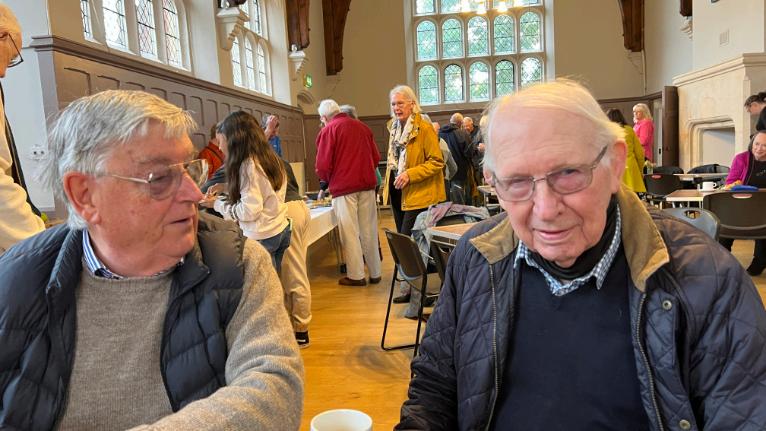

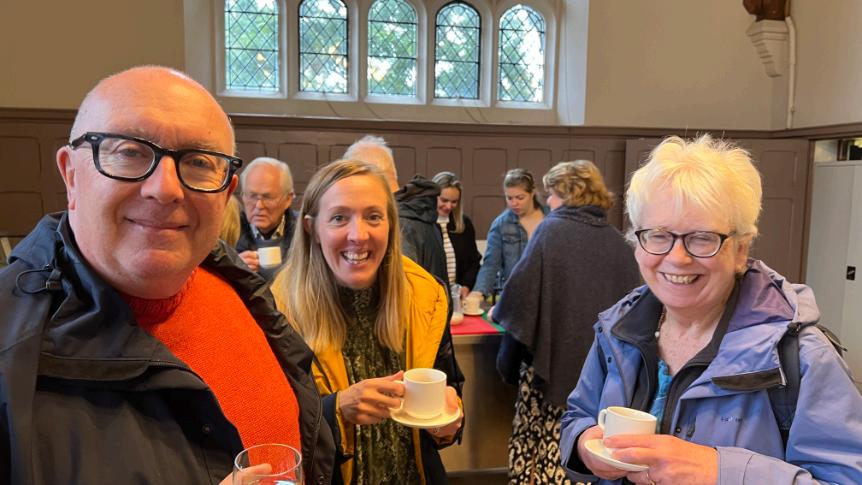



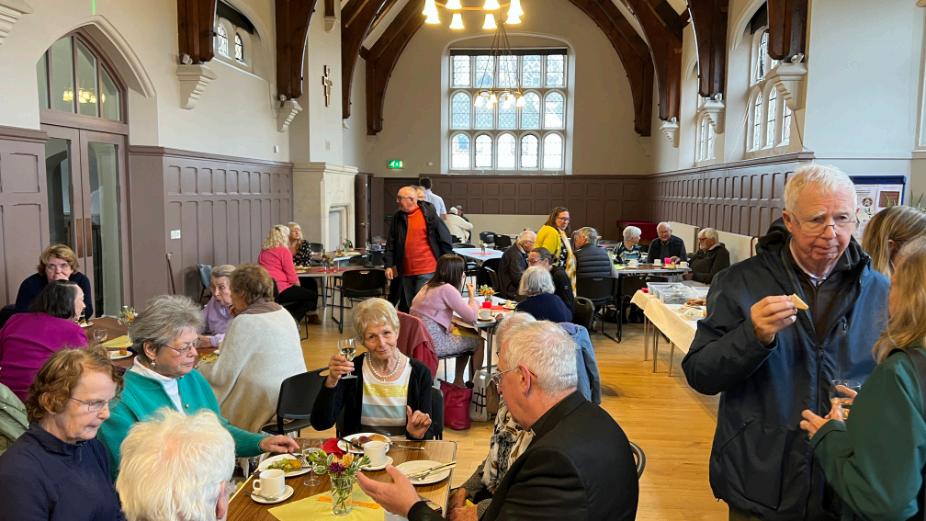



At the cemetry


Refreshments after the Blessing Ceremony

By Sandra Sedgwick

The risk of love is loss, and the price of loss is grief. Whatever your loss, we are here to listen and support
We are all trained bereavement facilitators.
Betsy is a semi-retired teacher and former SENDCO with mental health training.Margaret is a retired civil servant with years of experience with Samaritans.
Mary is a retired teacher, including those with special needs, and has counselling qualifications.
Sandra is a retired GP; she is also a founder and volunteer at St Wilfrid’s Hospice where she practises bereavement support.
Pauline is a retired teacher and a qualified counsellor with many years’ experience in private practice; she was also a facilitator in Beginning Experience in Catholic Ministry for separated, divorced or widowed.

If you have experienced loss, we are available to support you. We can talk on the phone or meet in person to help you on your journey. You can contact us via the Cathedral on 01903 882297. If you see us in the Cathedral, please feel free to speak to us.
Why not drop in for a Cuppa and a Chat at the Cathedral Centre every second Thursday of the month between 1.00pm to 3.30.

By Barbara Isbister



On the 16th of November 2024, on a perfectly ordinary Saturday afternoon, a most extraordinary event was taking place in Arundel Cathedral.
Organised by The Friends of Arundel Cathedral, with an introduction by Georgina, Duchess of Norfolk, Bishop Kenneth Nowakowski, the Apostolic Eparch of the Ukrainian Catholic Church of Great Britain was giving a talk entitled: ‘Culture in Ukraine, Past and Present.’
Bishop Kenneth Nowakowski’s (pronounced No Va Koff ski) talk about culture in Ukraine, included an introduction about himself.
‘Does he speak English? Does he have an Ukrainian accent?’ I asked someone who had met him previously.
Indeed, once Bishop Kenneth began to speak,
it immediately became apparent that not only was he a native speaker of English, but also, much to my surprise, that he spoke with a mixture of a Canadian and a standard British accent.
It was fascinating to learn a little about his life story. He was born in Canada and was in fact a fourth of fifth generation immigrant there; his great-grandfather having emigrated to Saskatchewan in 1896 as a result of Queen Victoria’s plans to settle the fertile land of the Prairies. Incentives were offered to farmers and labourers from European countries who wanted to settle in Canada. Many Ukrainians took up the offer, in search of a better life.
‘You must have only arrived today!’ is what Ukrainians jokingly say to people in Canada who claim to have not met any Ukrainians there. Between 1896 and 1905 the number of immigrants from Central and Eastern Europe rose from 16,000 to 140,000 per annum. Since then, many more emigrated to Canada after World War II. By 2016 Canada contained the second largest diaspora of Ukrainians in the world, after Russia.

Bishop Kenneth
Bishop Nowakowski also brought cultural artefacts for us to pass round and see: beautifully embroidered tablecloths and a basket of hand painted wooden ‘pisanki,’ (Easter eggs). He told us about special food, which included ‘borszcz’ (beetroot soup), and everyone’s favourite, ‘pierogi’ (dumplings).
The talk was accompanied by two 30minute musical performances by the Vivo Quartet. For some reason, I had imagined it would be a group of instrumentalists, playing violins, piano and perhaps an accordion. This would, in itself, have been wonderful.
However, what we were to have the privilege of witnessing was to be far, far beyond this. To say the a cappella performance (voices without instrumental accompaniment) by the four young men and women was exquisite and ethereal is no
exaggeration. Not only did the sheer beauty bring tears to my eyes, during the spellbinding music, but also it succeeded in conveying the very heart and soul of Ukraine.
The two separate a cappella phases consisted of two aspects of Ukrainian culture. The first was liturgical. The second, performed in national costume, was traditional music and folk songs. This was followed by the Ukrainian National Anthem and an outstanding solo performance by one of the singers. Altogether heavenly.
A very warm and enthusiastic ‘thank you’ by Georgina, the Duchess of Norfolk followed. Thank you to the Friends of Arundel Cathedral for organising such an inspiring event.
If you missed the event or if you attended and would like to listen to it again, it is available on the following link: https://arundelcathedralfriends.uk/ bishopkennethvisit
The Ukrainian Catholic Cathedral Duke Street, London W1K 5BQ Closest Underground – Bond Street
By Louise Sharp
Thursday7th 11.00am CathedralChapterMass&Meeting
Sunday10th 11.00am ArundelTownRemembranceService 11.30am SundayMass
Tuesday12th 10.00am DeaneryMassforDeceasedClergy
Wednesday13th 10.45am ConsolationGroupcoffee&chat
Saturday16th 2-4pm AnafternoonwithBishopKennethNowakowski FriendsofArundelCathedral: aruncathfriends@btconnect.com 01903884567
Saturday23rd 7.30pm TheAngmeringChoraleConcert http://theangmeringchorale.org.uk/
Tuesday26th 10.00am MassintheFitzalanChapel
Sunday1st 6.30pm AdventVespersandFriendsofArundelCathedral Socialaruncathfriends@btconnect.com 01903 884567
Tuesday3rd 6.00pm WorthingDeanerySchoolsAdventService
Wednesday4th 6.45pm CathedralDeanerySchoolsAdventService
Tuesday10th 9.30am MassintheFitzalanChapel 7.30pm Kent,Surrey&SussexAirAmbulanceCarolService forticketsseewww.aakss.org.uk
Thursday12th 6.30pm CaninePartnersCarolService forticketssee www.caninepartners.org.uk
Friday13th 4.00pm GreatBallardSchoolAdventService
Saturday14th 7.30pm ArunChoralSocietyCarolConcert forticketsseewww.arunchoralsociety.co.uk
Wednesday18th 2.00pm StPhilip’sSchoolKS2AdventService
Saturday21st 2.30pm Wedding
Tuesday24th 5.00pm VigilMassofChristmasatArundel
Tuesday24th 11.30pm MidnightMassatArundel
Wednesday25th 9.00am ChristmasDayMassatStorrington 11.00am ChristmasDayMassatArundel
Sunday29th 11.00am MassandlaunchoftheJubileeYear
JANUARY
Saturday11th 12.30pm Wedding
FEBRUARY
MARCH
Wednesday 5th ASH WEDNESDAY 10.00am MassanddistributionofashesatCathedral 7.30pm MassanddistributionofashesatStorrington
Saturday8th timeTBC DiocesanRiteofElectionService
Saturday12th 7.30pm
Sunday13th PALM SUNDAY
ArunChoralSocietyConcert forticketsseewww.arunchoralsociety.co.uk
Wednesday16th 6.00pm DiocesanChrismMass
Thursday17th HOLY THURSDAY
8.00pm
MassoftheLord’sSupperintheCathedralfollowedby waitingtomidnightatthealtarofrepose. 11.50pm Compline
Friday18th GOOD FRIDAY 9.00am
OfficeofReadingsandMorningPrayer 10.00am StationsoftheCross 3.00pm ThePassion–CollectionforHolyPlaces
Saturday19th HOLY SATURDAY
9.00am
OfficeofReadingsandMorningPrayer 8.30pm TheEasterVigilandFirstMassoftheResurrection
Sunday20th EASTER SUNDAY
Massesat9.00aminStorringtonand11.00amattheCathedral
Saturday26th 7.00pm
Sunday27th 2.30pm
BAPTISMS
LeconfieldSingersConcertfordetailssee www.leconfieldsingers.co.uk
ScoutingStGeorge’sDayParade&Service
EightchildrenwerebaptisedsinceFebruary2024
MARRIAGES
20thApril RichardEdney&ElaineGao
14thJune PaulNesbitt&Claire-MarieMcIlwain
20thJuly TomosShaw&AbigailMyerscough
21stSeptember EoinDoherty&Chien-YuChen
28thSeptember JosepheRomeu&AnjelaManzo
10thOctober DannyJohnVallis&EmmaHadley
DEATHS
22nd March PatrickDowling(83years)
Corpus Christi 2025 couldyouhelp?Maybeyou’reaflowerarranger,excellentwasherupperoryoulovetowelcomepeople?There’saroleforeveryoneatCorpusChristi.Contact theCathedralOffice.

56 MarionStratton
57 Unsplash
58-65 Wikimedia
66-69 Wikimedia,StellaMaris,Wikipedia
70-72 MargaretBamford
73 NigelCull
74-76 Unsplash
77-80 ElizabethStratford
81,82 AdamandBetsyVernon
83-85 BrydenIsbister
86 SandraSedgwick
87 LauraMaydew-Gale
88,89 Unsplash
90-91 BrydenIsbister
BackCover NigelCull
